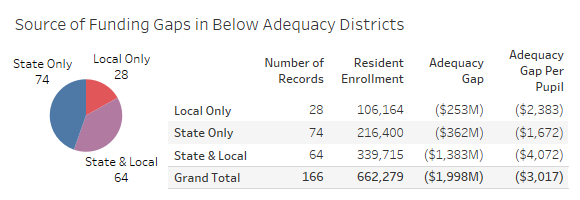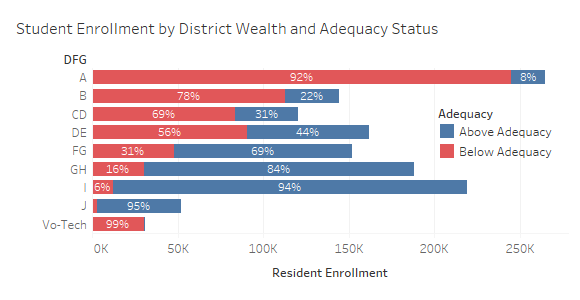166 NJ DISTRICTS NOW FUNDED BELOW “T&E”
ELC RECOMMENDS PATH TO FUNDING ADEQUACY
In 2018-19, 166 New Jersey school districts serving over 662,000 or almost half of all students statewide are funded below “adequacy” under the state’s weighted student funding formula – the School Funding Reform Act (SFRA). In total, these districts are below adequacy by almost $2 billion in state and local funding, or $3,017 per pupil.
Education Law Center has updated its analysis of district funding relative to SFRA adequacy levels based on 2018-19 data. The update shows a drop in the number of below adequacy districts from 185 in 2017-18 to 166 districts in the current year. [1] The drop reflects the impact of a $351 million increase in state aid in the FY19 State Budget, the first significant increase after eight years of aid cuts under former Governor Chris Christie, and a $383 million increase in the local levy to support school budgets.
The heart of the SFRA funding formula is each district’s “adequacy budget,” based on the cost of educating all students to achieve state standards, along with the cost of programs for low-income (at-risk) students, limited English proficient students, and students with disabilities. In 2009, the New Jersey Supreme Court ruled that, when fully funded to each district’s adequacy budget, the SFRA formula can deliver the essential resources – teachers, support staff and programs – necessary to provide a “thorough and efficient” (T&E) education, as mandated by the State Constitution.
The degree to which districts are below adequacy varies greatly, with some just below their SFRA target, but others behind by thousands of dollars per pupil. Twenty-four districts are spending more than $5,000 per pupil below their adequacy target.
Why Districts are Below Adequacy
ELC’s analysis shows that the 166 districts are below adequacy as a result of gaps in state aid or local property tax revenue – or a combination of both – as calculated by the SFRA. Twenty-eight districts are below adequacy because of local revenue gaps, while 74 are below because of state aid gaps, and another 64 are below because of a combination of state and local revenue gaps.

The 138 below-adequacy districts with state aid gaps are owed $1.49 billion in state aid. This represents a slight decline from the $1.61 billion owed to 153 districts in 2017-18. Thirteen districts are owed more than $5,000 per pupil, including Bound Brook, Lindenwold and Dover.
The 92 below-adequacy districts with local gaps are owed $1.1 billion in local revenue. Sixteen of the twenty districts with the largest local gaps are county vocational schools, but these districts make up some of that lost revenue by collecting tuition payments from sending districts. The non-vocational districts with the largest local gaps are Jersey City, Seaside Park Borough, Palisades Park, West New York and Vineland. Click here for a sortable list of below adequacy districts and their funding gaps.

Below and Above Adequacy Districts
The 166 below-adequacy districts are in every county and span the range of district types, from low to high poverty, urban to suburban and rural. The remaining 411 districts in the state are spending at or above the SFRA’s adequacy level, or more than is required for T&E.
Using the NJ Department of Education’s classification of districts based on community wealth and socio-economic status (district factor group or DFG), the relationship between district wealth and adequacy is clear. Ninety-two percent of students in the state’s lowest wealth (DFG A) districts attend schools that are spending below adequacy, while 95% of students in the state’s wealthiest districts (DFG J) are in schools spending above adequacy.
For a full list of all districts with adequacy status, state and local funding gaps, click here.

ELC’s Path to Funding Adequacy
In testimony to the Senate and Assembly Budget Committees in March, ELC presented a four-point plan to put New Jersey on the path to full funding of below adequacy districts beginning with the FY 20 State Budget proposed by Governor Phil Murphy and currently under consideration by the Legislature. The recommendations are:
- Target increases in state aid to the 138 below adequacy districts with state aid gaps. No district funded above adequacy should receive an increase in state aid until the aid gaps in below adequacy districts are eliminated. An increase of $484 million in the FY20 budget would put all districts on a path to full funding of the state aid component of their adequacy budget in four years.
- Reverse the proposed $40 million in aid cuts to 26 below adequacy districts as required under Senate Bill 2 enacted last year.
- Raise the property tax cap from 2% to 4% and mandate increases in local property tax revenue in below adequacy districts with local revenue gaps. Districts in municipal overburden, or those with total equalized tax rates in excess of the state average, should be exempted from this requirement.
- Cut $40 million of the $120 million appropriation to private schools and reallocate those taxpayer dollars to pay for the increase in state aid to below adequacy districts.
“Adequacy is central to the SFRA, and districts must be at or above their adequacy budgets to provide a thorough and efficient level of resources for their students,” said Danielle Farrie, ELC Research Director. “In making any adjustments to the formula, even in the annual State Budget, lawmakers must make sure that below adequacy districts move towards, and not away from, their SFRA adequacy targets.”
“Lawmakers must focus on a singular, constitutional objective: moving all districts to full funding of their SFRA adequacy budgets,” said David Sciarra, ELC Executive Director. “This is essential to ensure all of our school children are provided the essential resources necessary to give them the opportunity for success.”
[1] This differs from the total of 192 below adequacy districts originally published in 2018, due to a correction in how formerly non-operating districts are handled.
Press Contact:
Sharon Krengel
Policy and Outreach Director
skrengel@edlawcenter.org
973-624-1815, x 24
Press Contact:
Sharon Krengel
Director of Policy, Strategic Partnerships and Communications
skrengel@edlawcenter.org
973-624-1815, x240